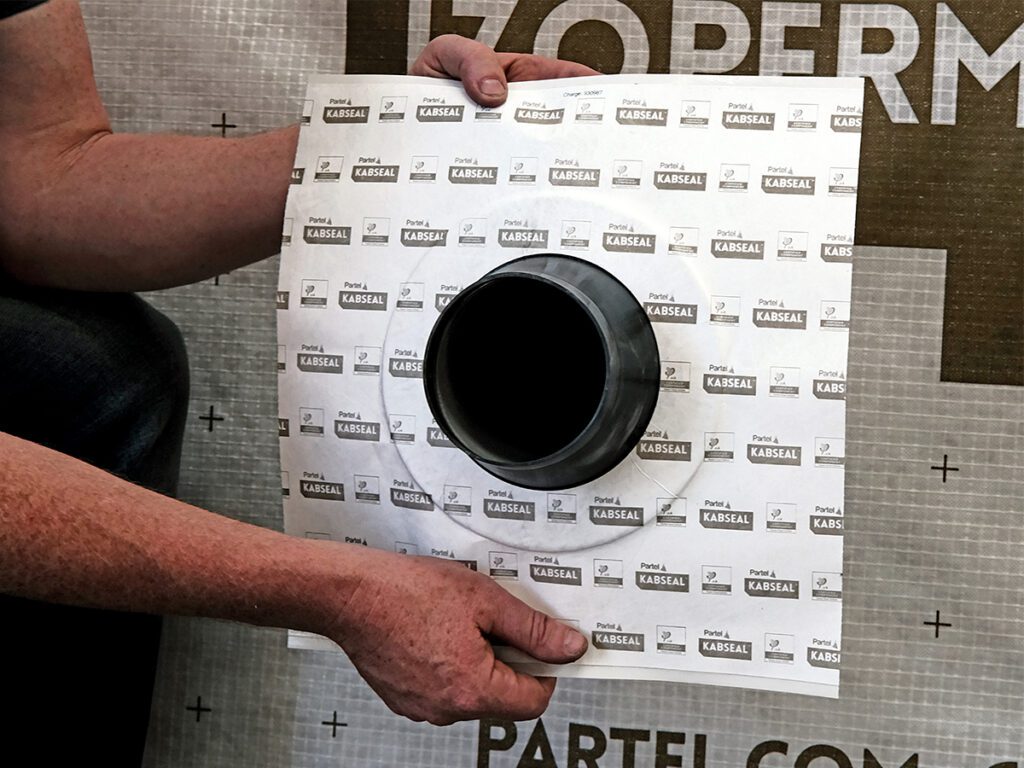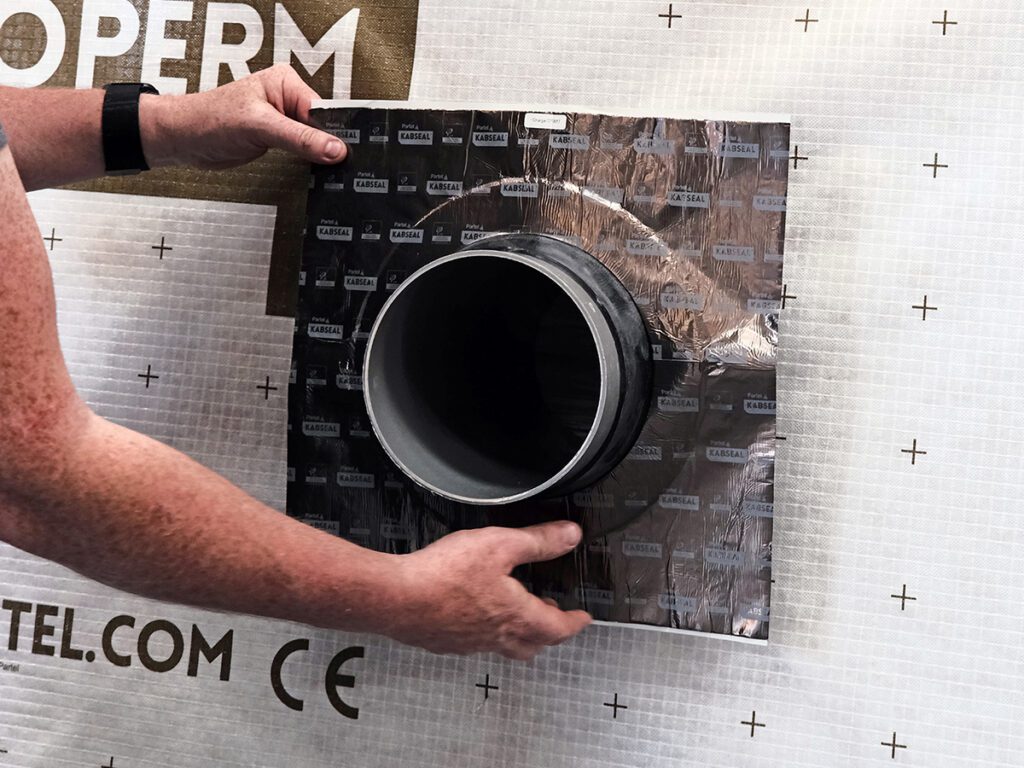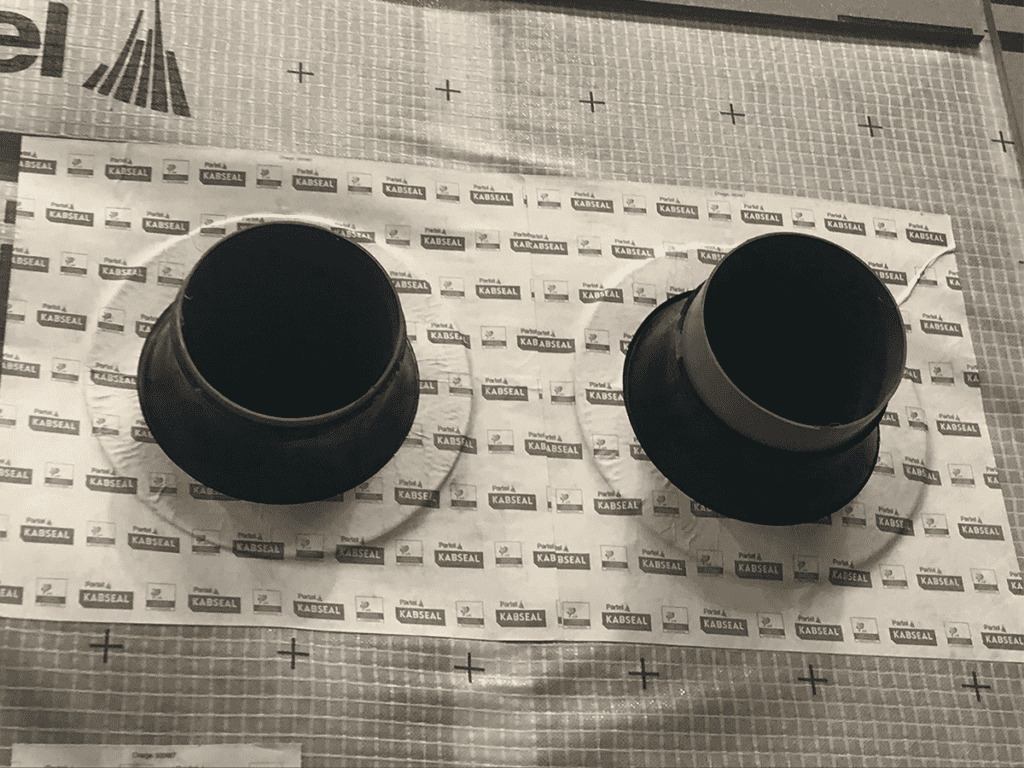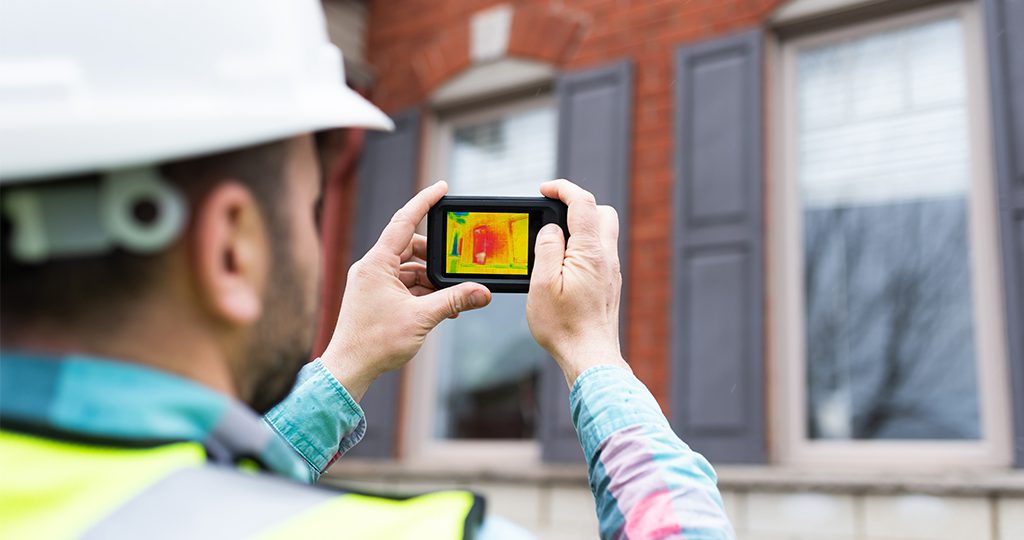Along with insulation, airtightness is one of the most critical factors for energy efficiency in buildings. One study found unwanted air leakage to be responsible for 11 to 15% of all energy use in UK houses1. Making buildings airtight can reduce draughts, heat loss and energy consumption.
The significance of penetration points
In any building, there will be dozens of points where pipes, cables, wires or ducts need to cross the airtight layer.
Along with junctions where walls meet floors, roofs and windows, penetrations are one of the most common points of air leakage in buildings.
Minimising the number of penetrations during design is the first step to preserving the integrity of the airtight vapour control layer (AVCL). Identifying and sealing any remaining penetrations is the next step.
In this blog, we will look at:
- Examples of common penetration points in buildings
- The consequences of inadequate sealing
- Airtight grommets and other specialist products for sealing penetrations
- How proper sealing of penetrations can help to reduce energy use, and make buildings healthier and more comfortable
Common penetration points in buildings
Electrical outlets, plumbing and cables create some of the most common penetrations through the AVCL. Let’s take a look at how each of these can affect airtightness.
Electrical outlets
For many buildings — especially timber frame — a service cavity can minimise the number of penetrations through the AVCL. A service cavity is a battened space between the interior wall finish and the airtight layer. It allows for the installation of electrical outlets, and the running of services, without penetrating the AVCL. Trades can also access the service cavity if needed without damaging the AVCL.
But when there is no service cavity, electrical outlets may need to be placed directly in the airtight layer.
Plumbing penetrations
Plumbing and ventilation penetrations are another common source of air leakage. Typical examples include:
- Flues
- Outside taps
- Heating pipes
- Wastewater pipes
- Ventilation exhaust and intake ducts
- Water supply
- Gas supply
- Kitchen hood extracts
Cables
Electrical cables can also cause air leaks where they penetrate the airtight layer. Thoughtful design can minimise the number of these penetrations and make it easier for them to be sealed later.
How unsealed penetrations lead to air leakage
Failing to properly seal penetrations will result in air leaks. Unsealed penetrations cause cold air to enter the building, or warm air to exit. Here’s how:
Stack effect: During cold weather, warm indoor air is less dense than cold outdoor air. Warm air rises in the building and forces air out through cracks and gaps at the upper level. To compensate, cold air is drawn in through cracks and gaps lower down.
Wind: The windward side of the building is subjected to positive air pressure. This pushes air indoors through unsealed gaps, while at the same time, negative pressure on the leeward side draws air out of the building.
Ventilation systems can also create a pressurised building and push air out through unsealed gaps.
The consequences of inadequate sealing: energy, comfort and moisture
Air leaks make a building less comfortable. We’re all familiar with the feeling of a cold draught coming in through a badly sealed window.
But apart from obvious leaks like this, the sum of dozens of tiny air leaks can lower the indoor temperature. You then turn up the thermostat to stay comfortable, driving up your energy bills.
Gaps in the building envelope can also facilitate the movement of moisture into the fabric. Warm air holds more moisture, and because it is warmer inside than out through most of the year in Ireland and the UK, vapour pressure drives moisture out through the building fabric. When temperatures drop, any water vapour that gets trapped in the fabric may condense to liquid water, leading to damp and mould.
Detailed air sealing with innovative products
Thankfully, there are now a variety of innovative solutions on the market for sealing common penetration points.
Airtight back boxes for electrical outlets

Whenever you need to place an electrical outlet directly into the airtight layer, you can seal it with an airtight back box.
An airtight back box is a flexible housing that is installed in the AVCL. The electrical outlet is then fitted within the airtight back box. Partel’s ELECTRISEAL box contains grommets that guide cables into the airtight housing to ensure these are air sealed.
Sealing plumbing penetrations with airtight grommets
Airtight grommets can be used to guide round penetrations such as pipes, cables, wires or ducts through the AVCL while forming a tight seal around the penetration. Flexible airtight tapes can also be used to seal around penetrations, but grommets are generally quicker and easier to install.
- Airtight grommets are typically made from EPDM, a synthetic rubber that is highly durable and flexible
- Grommets are undersized relative to the pipe or cable. This allows the grommet to tightly grip the penetration, creating an airtight seal.
- The base of the grommet is sealed to the airtight layer. Partel’s KABSEAL range of grommets is self-adhesive so it does not require a separate tape for attachment to the AVCL.

Advantages of using airtight grommets
Airtight grommets offer a number of advantages over tapes.
- They are generally quicker and easier to install
- They are flexible and allow for some movement of the building elements over time
- Grommets don’t rely on adhesives, so there is no danger they will become unstuck if they are moved
How to select the right grommet for plumbing penetrations

The most important thing to consider when choosing an airtight grommet is the size of the penetration. Partel’s KABSEAL PRO grommets are available for penetrations with diameters ranging from 4 mm up to 220 mm.
Apart from size, you may also need to choose a specialist grommet depending on the application. For example:
- KABSEAL HEAT is designed for hot pipes and ducts and can withstand temperatures up to 250C
- KABSEAL GAS is specifically for penetrations that need to be radon-proofed
- KABSEAL SLAB is a potting grommet designed for sealing supply lines that run close to each other in the floor slab or sub-base
Sealing cable entries with airtight grommets
Just like plumbing penetrations, airtight grommets can also be used to seal electrical wires and cables.
Partel’s KABSEAL PRO range is suitable for wires with a diameter from just 4 mm. And where multiple cables are grouped together, KABSEAL PRO 6 can seal up to six cables through the same grommet.
Benefits of airtight grommets & detailed air sealing
According to a study2 conducted by the Air Infiltration and Ventilation Centre, an arm of the International Energy Agency, airtight grommets offer a comparable level of airtightness to flexible butyl tape when sealing around penetrations, but are more durable. Thus, grommets can offer a number of benefits over the lifetime of the building:
Energy efficiency: By providing durable and effective air sealing, grommets help to reduce energy use in the long-term. They also prevent the movement of air into the building fabric, where it can reduce the performance of insulation, an effect known as “thermal bypass”.
Indoor air quality: Air leaks can bring dust, spores, and other pollutants into a building. An airtight envelope helps to prevent pollutants such as these from entering a building.
When making a building airtight, it is also essential to install a quality ventilation system to remove indoor pollutants and bring fresh air inside. Research shows that passive houses, which are highly airtight and have mechanical ventilation systems, generally have better indoor air quality than conventional dwellings3.



Occupant comfort: Proper sealing of penetrations also makes buildings more comfortable by reducing draughts and air movement. A study of 14 Irish dwellings that were given airtightness, insulation and other upgrades as part of SEAI’s deep retrofit pilot programme found that all homeowners felt more comfortable in their homes after the retrofit than before, both in summer and winter4. All of the buildings had air permeability values of between 2.4 and 5 m3/hr/m2 post-retrofit – in many cases the upgrades reduced this from figures higher than 10 m3/hr/m2.
Conclusion: airtight grommets for healthy, high-performance, low-energy buildings
Airtight grommets and back boxes can play an important role in improving the energy efficiency, health and comfort of buildings by providing durable seals for common penetration points. To recap:
- Penetrations for pipes, cables and electrical outlets are some of the most common points of air leakage in buildings
- Air leaks can reduce the performance of insulation, facilitate damp and mould, and make buildings less comfortable
- Innovative products such as airtight grommets and back boxes make it faster and easier to seal these penetrations, and they provide durable seals
- This can help to protect your building fabric, reduce energy bills, and create a healthier and more comfortable building






